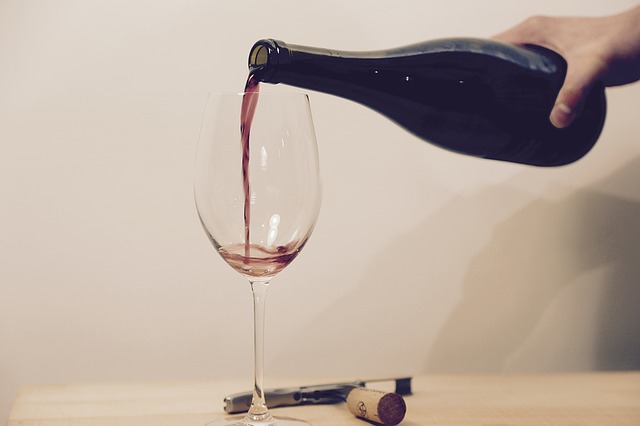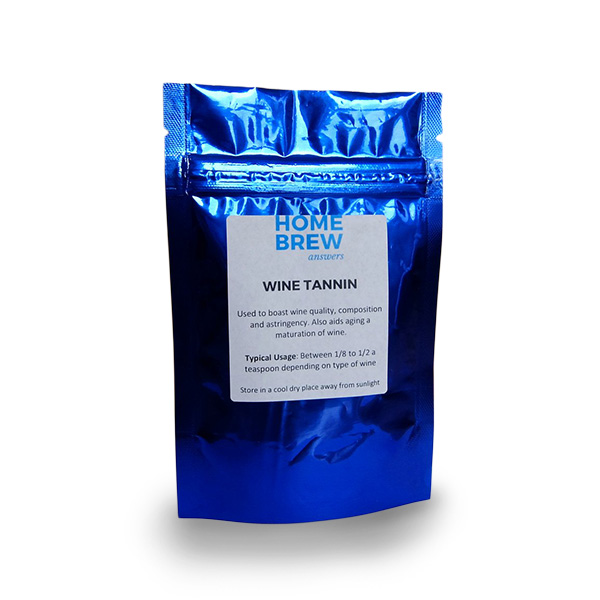What Is Wine Tannin & How To Use It
Tannin also known as tannic acid is a compound found in wines, most notably red wines that give them a pleasing dryness. Wine tannin is also an additive for increasing the tannin present particularly in country wines that use fruit, vegetables or flowers. If you look at some of the wine recipes here you will see it is in most of the fruit wines even if it is only a tiny amount. What is wine tannin and why is it needed? That is what we are going to cover in this article.
What is Wine Tannin
Tannin is an astringent polyphenol that is naturally occurring in plants, wood, bark and leaves. You have probably heard people describe some red wines as having high tannin content. This is because of grape skins, seeds and stems contain tannins. Different varieties of grape contain more tannin than others and this is why certain varieties of wine are characterised by having an astringency.
Wood also contains tannin and it is notable that wine aged in barrels and wooden casks are more astringent than other wines. The word tannin refers to the use of wood used in tanning process of turning animal skins into leather.
Unripe fruit has a higher tannin content than ripe fruit and this trait stops animals from eating the fruit before the seeds are ready to be dispersed by these animals, tannin in the leaves also inhibits predation by herbivores.
In a similar fashion, grape growers can monitor the tannin content of grapes, when the tannin content drops low enough as the grapes ripen they can determine the best time to harvest the grapes produce a balanced wine. A wine that has the right amount of tannin and is not too astringent at the same time as having the correct dryness, balance and mouthfeel.
Tannin is produced by extraction using a solvent from organic matter such as grape skins. The liquid is called tannic acid and is then dried which produces a tannin powder.
Adding Tannin to Fruit Wines
Wine making grapes have a tannin content that makes wines that have a pleasing astringency. For the country wine maker however, there are not many fruits that have a similar level of tannin. This is a problem because the character that emerges in some fruit wines with low amounts of tannin is flat and dull. It can seem as if there is something missing.
Many older recipes call for tea to be added to a wine. Strong tea is astringent because it is full of tannins. Adding tea was a simple method to introduce tannin to a fruit wine that had low levels of tannin.
Elderberries contain a level of tannin close to wine making grapes, blueberries and blackberries have some but not quite at the level of grapes. In the case of most fruit red wines you make at home, the addition of wine tannin is beneficial to the quality of the wine. White wines will usually not require an addition of tannin or only very tiny amounts.
Wine tannin is a brown powdered additive which makes it extremely easy to adjust your wine. Just add tannin to the must and mix thoroughly.
What we really hope to achieve by adding tannin is to mimic the mouthfeel and dryness that we find pleasant in grape wines. Now, this is of course down to personal preference, some people find even the smallest amount of astringency unappealing, others like it. So how much tannin is needed?
How Much Tannin To Add?
Most tannin comes in powdered form here in the UK and in most cases, the package recommends around 1/8 – 1/2 teaspoon per gallon of wine. This is a rough guide, I would, however, suggest following a recipe rather than adding one teaspoon into every wine you make.
White wines, for example, will often need less tannin than red wines. Some fruits like elderberries and blueberries already have a modest amount of tannin in their skins so will require less. If a recipe states how much tannin to add then follow that advice.
The good thing about adding tannin is you can add it at any point before, during or after fermentation.
I will always add a small amount of tannin before fermentation, allow the wine to ferment and condition and when it comes time to rack the wine to a new vessel, test a sample. At this point, I can see if more tannin is required to balance the texture of the wine and dry it out further.
It is always best to add a little, then add more if necessary. It is more difficult to cover up excess tannin so err on the side of caution
If you are unsure of how much tannin to add then add a small amount, you can always add more if required after testing a sample. The next time you come to make the wine you will have a better idea of exactly how much tannin will be needed.






Hi, I’m planning on starting a batch of strawberry wine in this lockdown period. Having read your article, it’s clear to me I need to add some tannins to my strawberry must. Problem is, I don’t have any tannin powder on me, and I obviously can’t get any at this time. I looked up a few alternative sources for tannins – and well, I have some medium toasted French oak chips on hand, but I’m not sure I want that oaky flavour in a sweet strawberry wine. Can I use something else, like cinnamon sticks or strong black tea as alternative tannin sources? I just want a subtle flavour from these, and don’t want them to overpower the strawberry flavour. Which would you recommend I use?
Tea was commonly used before commercially available tannin. Raisins will also add some tannin and also some body, a few handfuls will be enough.
There are some fruit and herb teas containing Strawberry and Raspberry, some even containing a little Hibiscus flower (very good for mouth-feel). I usually have something like this in house already, but even if you haven’t, you should be able to find something like this in your supermarket, when you’re out to get your loaf of bread or carton of milk in any case….
Hi Neil,
I make a bit of fruit wines from store bought juice.mosyly cherry, apple and bluberry.
I’m a woodworker and planning to make small kegs for aging.
Would you recommend still adding tanning from ferment to rack or since some tannin would be added by the wood, should I add after aging?
Thanks in advance. Phil
Hi Phil,
You are right, I would leave out the tannin as the wood will add plenty. Sample after aging in wood but I doubt you will need to add any.
Sounds great.
Cheers
Hi
I’ve tried to make my own wine from scratch by reading books and YouTube.
There’s no local amature wine making in my area, East Riding of Yorkshire.
I’ve made some plum wine and I opened it yesterday and found it to be very sweet. I also made some rhubarb and ginger last year, not bad. I’m thinking of mixing them. Is it OK to do that.
Also as I am learning on my own, is it crucial to use a Hydromiter
Many thanks
Steve
It is a great idea to blend wines and commonly done by commercial wineries. I would suggest purchasing a hydrometer as it will help you monitor how much sugar is in solution and how sweet or dry the wine is going to finish.
Pls I want to in venture into wine production, my research shows that need to be age before consumption is there any alternative to this
I am afraid not. A lot of wines will peak after a year or so, lower alcohol content may age quicker but don’t have the same character as wines.
Hi Neil,
I’m in the process of making a simple plum wine and just put it in my demijohns. How do I add the tannin to my wine? Do I just measure the amount and drop it into the demijohns or do I need to mix it with something? The recipe I’m using doesn’t call for anything other than the plums, sugar, yeast, and water. Thanks for your article it is great information.
You can mix with a small amount of water if you like or just stir in with a sanitised spoon.
I brew a variety of fruit wines… currently have aparsnip, a raspberry and a black forest (from frozen) on the go…
About Tannins… is there a rule of thumb that between tea and powdered tannin
Eg… half a strong cup = half a teaspoon?
Thanks